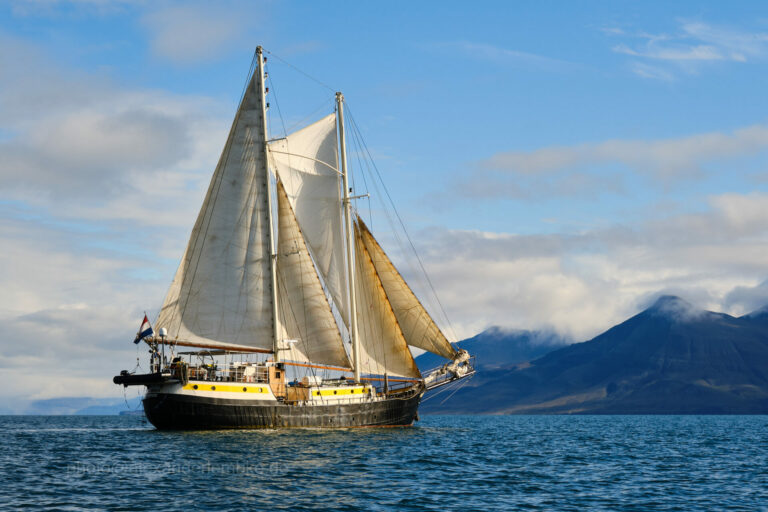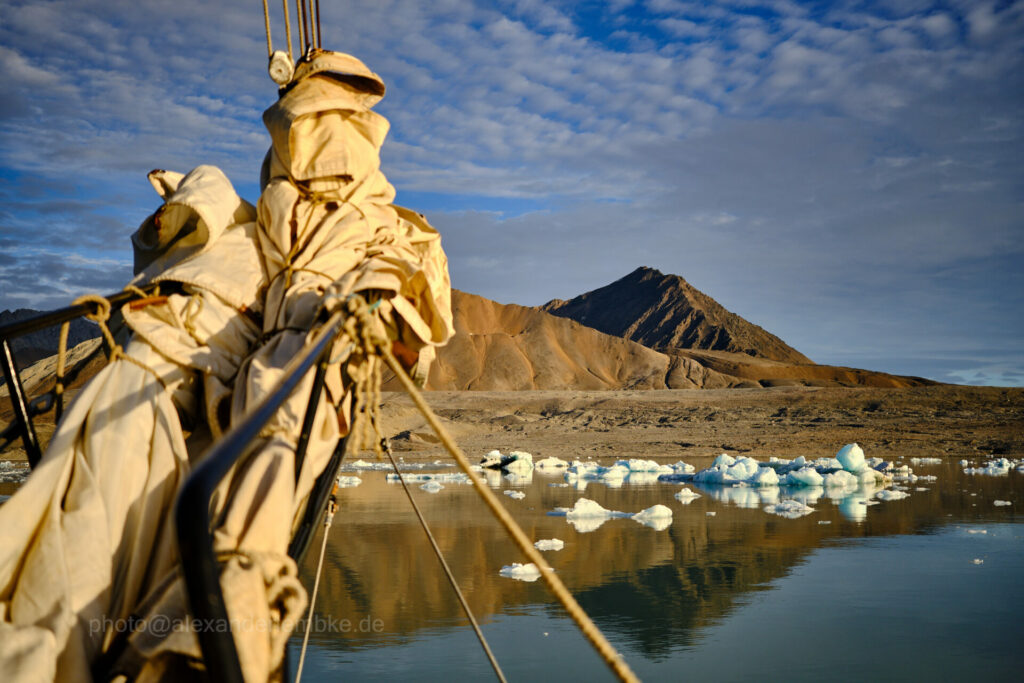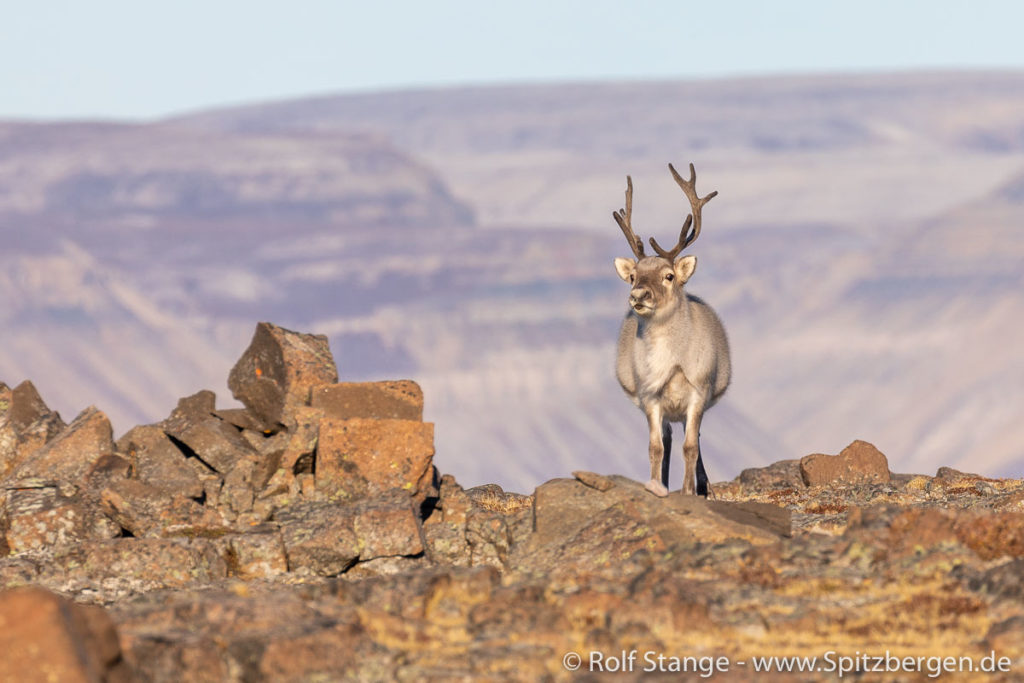Svalbard august
Circumnavigating Svalbard in the light of late summer.

Price Standard Cabin
Price Comfort Cabin
Day of Embarkation
Time of Embarkation
Port of Embarkation
Day of Disembarkation
Time of Disembarkation
Port of Disembarkation
€7.490,-
€7.990,-
26-08-2026
14:00
Longyearbyen
11-09-2026
12:00
Longyearbyen
The trip
From August 26th to September 11th, 2026, we want to explore the landscapes and wildlife of Spitsbergen aboard the two-masted motor sailboat Meander. By late summer, the Hinlopen Strait will most likely be free of ice, allowing us to circle the main island. This time of year offers particularly beautiful light. The endless midnight sun retreats, and the first sunsets bring hours of stunning light. A fascinating phenomenon: at the start of the journey, we will experience twilight, but by the end of the trip, we will experience full darkness during the night. For those who enjoy nature photography, this trip offers numerous and varied opportunities.
Land excursions and hikes will be the focus. We will explore remote parts of Spitsbergen on foot, giving us intense and rare nature experiences. For all participants, we expect a love for hiking in pathless, sometimes rocky terrain, as well as the willingness to contribute to a harmonious atmosphere and the smooth operation of daily life on board. This includes group compatibility and the readiness to assist with daily tasks. We won’t be on a relaxation vacation, but instead, we offer pure Arctic experiences, exciting encounters, and silence— with plenty of time to enjoy it all.
The expedition-like experience on hikes, immersing ourselves in Spitsbergen’s nature, wildlife, and history in all its diversity, is the main focus of this journey. The Arctic-experienced guide, Rolf Stange, will accompany you on daily land excursions, helping you discover the unique features of the Arctic’s nature and wildlife. From leisurely walks and hikes to old huts, to small mountain tours, or sailing through glacier ice with the Meander, we will experience it all. Land excursions normally last between two and four hours, but if the weather permits, we’ll provide packed lunches for longer tours. Occasionally, we may split into smaller groups, as we travel with two guides. It is not possible to go ashore individually outside of the group. Due to the risk of encountering polar bears at any time, the group will always be accompanied by an armed guide. There will, of course, be regular breaks for photography, resting, and observing. Basic sure-footedness and a reasonable level of fitness are required, as well as the motivation to participate in multi-hour hikes.
On the ice or along the coast, we might encounter polar bears or walruses. Whales may also occasionally appear. If an opportunity for wildlife observation arises, we will certainly seize it.
By the end of August, the ice, with few exceptions, has retreated north, and there is still enough light for night-time navigation, making it a perfect time to circle the main island of Spitsbergen. The time window is intentionally long to account for the weather. We reserve the right to shift the focus of the journey to a versatile Spitsbergen experience with many landings instead of attempting a circumnavigation, in case of extended storms around the southern cape. In such a case, we would prioritize enjoying Spitsbergen over enduring poor weather and rough seas on open stretches like around the southern cape. This is an extreme scenario, but the chances are high that we will successfully circumnavigate Spitsbergen within 16 days.
If we need to cover longer distances or perhaps wait for weather while anchored, we offer a library on board and opportunities for social gatherings, as well as lectures on the local area. On our journey along the special coastline of Spitsbergen, we will pass glaciers and jagged mountain peaks, which can be wonderfully admired from deck. A journey to Spitsbergen is particularly enjoyable when there is enough time to savor it, avoiding the “land sickness” of stress. In the evening, anchored in a beautiful bay with a view of the glaciers, you can relax with a glass of wine or a book on deck or in the salon. This is the magic of Spitsbergen and a journey aboard the Meander.

Route
There is no fixed itinerary. Rolf Stange, with his extensive experience in Spitsbergen, will work with the captain to decide the plan flexibly, depending on the ice, wind, and weather conditions. The focus of this trip is on the nature experience, not on reaching specific places. Ultimately, we will decide based on the situation and the weather to ensure we spend as much time as possible in the most beautiful areas accessible to us under favorable weather conditions. However, we will most likely land in the following fjords:
- Isfjord: The largest fjord of Spitsbergen, it combines nearly the entire landscape and biological diversity of the entire archipelago in its many branches. Longyearbyen, where the trip begins and ends, is located here.
- St. Jonsfjord: A peaceful, beautiful fjord north of Isfjord. Short hikes offer great views of the subtly colorful landscape.
- Forlandsund: The shallow waters allow the Meander, as one of the few ships, to pass through the very shallow Forlandsund between Prins Karls Forland and the main island of Spitsbergen. In this area, we hope to observe walruses at the anchorage.
- Kongsfjord: The scenic panorama of Kongsfjord has long captivated whalers. Today, Ny-Ålesund, converted into a research settlement, is located here, featuring the airship mast from which Amundsen and Nobile launched their famous Arctic expeditions. It also holds the northernmost post office in the world.
- Krossfjord: This sea arm is highly branched, so we could easily spend days here. The picturesque fjord has served as a backdrop for historical events, from whaling to a German weather station during World War II, all set against the backdrop of large glaciers and rugged mountains. Krossfjord also offers some exciting spots to observe Arctic wildlife.
- Raudfjord: The west side of this fjord is characterized by Alpine Arctic landscapes with steep mountain slopes and glaciers. Steep cliffs host seabird colonies, and in early June, parts of the fjord are likely still covered with solid ice, often with seals lounging on it.
- Woodfjord: This long sea arm runs along Andrée Land, known for its rounded mountain shapes and colorful rocky slopes. Woodfjord has two branches, the Bockfjord and the Liefdefjord.
- Wijdefjord: This fjord stands out on the map due to its straight, long shape. On the west side lies Andrée Land, and on the east side rises the heavily glaciated high plateau of Ny-Friesland. The interior of Wijdefjord is dominated by the Mittag-Leffler Glacier. The Wijdefjord was the site of the tragic failed Schröder-Stranz expedition in 1912/13. Although it’s rarely visited, it offers beautiful landscapes and landing opportunities.
- Hinlopen Strait: This strait separates the main island of Spitsbergen from Nordaustlandet, the second-largest island of the archipelago. The landscapes on both sides of this sea channel are characterized by vast, expansive areas with enormous ice caps. Large seabird colonies thrive here, and the area offers good chances for spotting other wildlife. The sparse vegetation in many areas earns the region its ecological title of “Polar Desert.”
- Nordaustlandet: The second-largest island in the archipelago is mostly glaciated and features the longest glacier edge in the entire northern hemisphere.
- Heleysund: The narrow strait between Barentsøya and Spitsbergen experiences impressive, strong tidal currents, making it only passable under favorable conditions. Alternatively, we may pass through the Freemansund between Barentsøya and Edgeøya.
- Barentsøya and Edgeøya: Located in the southeast of the archipelago, these islands feature expansive plateau mountain landscapes. Less glaciated than Nordaustlandet, Barentsøya and Edgeøya have wide, seemingly lush tundra areas with large reindeer populations, while other places are marked by mighty cliff coasts, making them inaccessible.
- Northern Storfjord: Situated between Spitsbergen and the southeastern islands of Barentsøya and Edgeøya, this fjord features Negribreen, one of the largest glaciers in Spitsbergen. On the wild east coast of Spitsbergen, there are several bays and coasts we may explore.
- Sørkapp (South Cape): A prominent and exposed area with unprotected waters. We expect to make distance on this stretch, likely resulting in a full day of sailing.
- Hornsund: No wonder this area is considered a scenic highlight, as it’s surrounded by several large glaciers and some very remarkable mountains.
- Bellsund: This area offers a scenic variety, from vast tundra areas to a series of characteristic small islands and land projections, all shaped by unique and striking geology, and culminating in beautiful mountains. Along the shore, remnants of the “Gold Rush era” from the early 20th century can be found, as small mines sprouted up here like mushrooms in other places.
We hope to show you as much of the Arctic wildlife as possible: Arctic foxes, walruses, birds, whales, and of course, polar bears. Our crew will do everything possible to visit the best wildlife observation spots, but of course, we cannot guarantee sightings. We will not be conducting a “polar bear safari,” but thrilling encounters can happen around every corner!

Life on board
Onboard the deckhouse, there is a cozy salon and a separate kitchen from the salon. Below deck, there are six double cabins for passengers, each with a washbasin. Two of these cabins are equipped with their own shower and toilet (“Comfort Cabins”). The “Standard Cabins” share two showers and two toilets. The mattress length is between 195 and 200 cm, with a width ranging from 69 to 99 cm. Some mattresses are cut so that the foot end is slightly narrower than the head end. Central heating ensures comfort. The cabins have 230V power outlets.
While at sea, you can chat with your fellow travelers in the warm salon over a cup of tea or coffee. Meals are also served here, prepared by the cook. There are some books and specialized literature available. Occasionally, readings or presentations will be held here by the guide, Rolf Stange. The Meander does not have extra service staff. At a minimum, you should return your used coffee cup, and help with washing dishes after meals is welcome. Bed linens and towels are provided on board.
Sailing on the Meander, in harmony with the natural elements, is what makes this journey unique. We follow the weather, wind, and nature, and as such, our itinerary is often developed while underway. During sailing maneuvers, a helping hand is occasionally needed. However, guests are not part of the watch schedule.
Seasickness will not be a common experience, and we will plan according to the weather forecast. Nevertheless, seasickness cannot be ruled out and is, after all, a part of any sailing journey. You must be able to move safely through the ship even in rough seas. Boarding and disembarking from the dinghies should also not pose problems for you.
The hikes, in the snow-covered early summer, will be rather short but can still be strenuous. You need to be in generally good health and fit enough for several-hour hikes in trackless terrain. Extreme sports or technical climbing, etc., are not part of the program, but you should enjoy hiking, even in trackless, rocky terrain. The constant possibility of encountering sometimes grumpy polar bears on land means we will always stick together as a group.
All guests must be able to reach the deck quickly and independently, in the unlikely event of an emergency such as a fire. Participants who are clearly unable to do so may be excluded from the trip at short notice by the captain or trip leader if their safety cannot be guaranteed in an emergency, for example, in the case of a fire. This does not entitle you to a refund.
There is no doctor aboard the Meander. In case of medical emergencies, the rescue helicopter from Longyearbyen will be requested. In case of bad weather, this may result in several hours of delay or might simply be impossible. Complete medical care is not available in Longyearbyen, and in an emergency, an air ambulance to Tromsø may be required, which will take extra time and incur additional costs. Your personal health/travel insurance must, if applicable, cover the cost of such an operation. Before the trip, you will receive a form to provide any medically relevant information. Allergies and dietary preferences should also be listed here. The captain and trip leader will be able to access this information during the journey, in case they need to provide it to a doctor. We have a comprehensive pharmacy on board, and the nautical crew is medically trained.
And now for the bad news: Participation is not free of charge. The price is 7.490 euros (Standard Cabin) or 7.990 euros (Comfort Cabin with private shower and toilet) from and to Longyearbyen. Flights and other accommodations must be arranged and paid for separately. You can book individually and will then share a cabin with a fellow traveler of the same gender. A single cabin can be booked for an additional charge (subject to availability). The price includes the trip aboard the Meander from embarkation in the afternoon of August 26, 2026, to disembarkation in the morning of September 9, 2026, including all activities and all meals on board with tea, coffee, and water. Other beverages on board are to be paid for separately. Not included in the price are travel to and from Longyearbyen and any additional overnight stays. We recommend arriving in Longyearbyen a day before embarkation. If flights are delayed or luggage arrives late, it must be assumed that the Meander cannot wait. Depending on arrival and departure times, a personal exploration of Longyearbyen may be worthwhile.
Included in the price:
- Accommodation in twin cabins (Standard/Comfort)
- Towels and bed linen
- Full board on board
- Port fees
- Coffee, tea, and water
Not included in the price:
- Transfer costs
- Soft drinks and alcoholic beverages (Bar on board)
- Travel insurance
Important information:
- A passport or ID card must be carried
- Please do not use hard-shell suitcases, as they are difficult to store
- All onboard expenses can be settled at the end of the trip
- Card payments are not possible on board
We look forward to welcoming you on board! If you have any questions, feel free to email us at info@sailing-expeditions.com
See you soon,
Mario Czok
